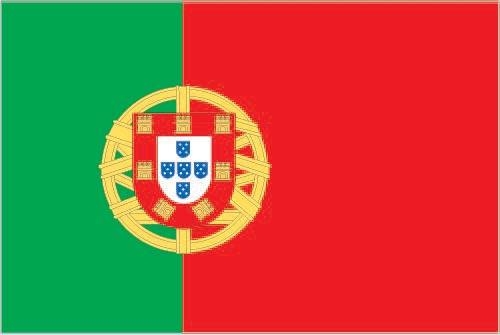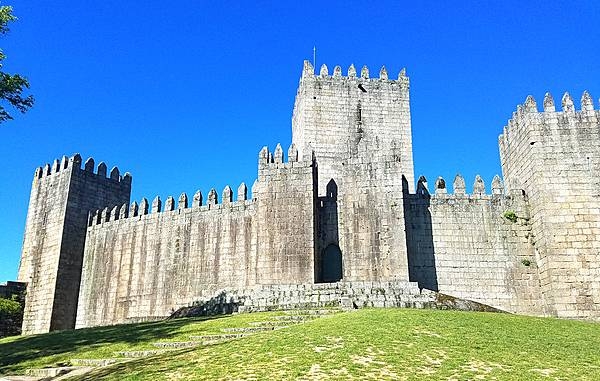103 Portugal

Two vertical bands of green (hoist side, two-fifths) and red (three-fifths) with the national coat of arms (armillary sphere and Portuguese shield) centered on the dividing line. Explanations for the color meanings are ambiguous, but a popular interpretation has green symbolizing hope and red the blood of those defending the nation.
Flag courtesy of the CIA World Factbook

Map courtesy of the CIA World Factbook

The castle in Guimaraes was built in the 10th century to protect a nearby monastery from Moors and Norsemen. As the first capital of the nation and birthplace of its first king, Guimaraes it is one of Portugal’s most historic cities and one of the most attractive places to visit in the country. Its historic town center is listed as a World Heritage Site in recognition of its being an “exceptionally well-preserved and authentic example of the evolution of a medieval settlement into a modern town” in Europe.
Photo courtesy of the CIA World Factbook
Government
According to Britannica, Portugal has been a republic since the overthrow of King Manuel II and the house of Bragança in 1910. From 1910 to 1926, the era of Portugal’s First Republic, a parliamentary democracy was established, though monarchists attempted to overthrow it, and factions quickly arose among republicans. In 1926 a bloodless military coup overthrew the republic, replacing it with an authoritarian government. In 1932 António de Oliveira Salazar established a corporative dictatorship, the so-called Estado Novo (New State), that lasted until 1974, four years after Salazar’s death. During the dictatorship, democratic-like institutions existed but were merely a facade, stacked with supporters of Salazar; political freedoms were suppressed, sometimes ruthlessly. Since the Revolution of the Carnations on April 25, 1974, Portugal has had a democratic republic. Its post revolutionary constitution, first adopted in 1976 and modified several times since, established a semi-presidential system whereby executive power was divided between a president and a prime minister. The constitution was revised in 1982, when ideological elements were minimized, and again in 1989, when the way was paved for privatization and a transition to a free-market economy.
Portugal’s chief of state is the president, who is directly elected by universal suffrage for a five-year term and may be elected to only two consecutive terms. The president is responsible for guaranteeing Portugal’s independence and national unity. Presidential duties also include serving as chief commander of the armed forces, appointing and dismissing the prime minister (who must be able to command majority support in the legislature), appointing and dismissing other members of the government at the proposal of the prime minister, sending messages to parliament and convening or dissolving it as necessary, and setting the dates of elections after consultation with the Council of State.
The constitution designates the Council of Ministers, the cabinet, as Portugal’s chief policy-making body. The cabinet consists of the prime minister, who presides over its meetings, the ministers of government departments, and some secretaries of state (ministers without portfolios). The prime minister is simultaneously responsible to the president (regarding the overall functioning of governmental institutions) and to parliament (regarding the content of public policy). The prime minister directs, coordinates, and implements government policy. By tradition the prime minister is the head of the civil service.
The parliament comprises the unicameral Assembly of the Republic, which has 230 deputies. Its duties include debating and voting upon legislation, authorizing the government to raise revenues, and approving the laws passed by the legislatures of the autonomous regions. The parliament may also dismiss the government by rejecting a vote of confidence requested by the government or by passing a motion of censure against the government.
Portugal has three tiers of government below the national level. The lowest tier comprises the parishes (freguesias), of which there are about 4,000. Each parish has a directly elected assembly (assembleia de freguesia), which appoints its own executive body, the parish board (junta de freguesia). The second tier consists of the municipalities (concelhos), which number some 300. Municipalities include rural and urban areas within their territorial limits. Each municipality has a municipal assembly (assembleia municipal), made up of the presidents of the boards of the constituent parishes and an equal number plus one of directly elected members; a municipal chamber (câmara municipal), which is the executive of the municipality; and a municipal council (conselho municipal), a consultative organ through which the views of social, cultural, professional, and economic organizations within the municipality are transmitted to the municipal chamber. Above the municipalities are 18 districts (distritos), 20 including Madeira and the Azores, each with an appointed civil governor.
The constitution of 1976 called for the establishment of administrative regions (regiões administrativas), and the government created plans to subdivide the country, but by the early 21st century such a scheme had yet to be implemented (and had been rejected in a national referendum in 1998). Nevertheless, to simplify the implementation and administration of EU programs, the government devised a system consisting of five regions for the mainland: North (Norte), Central (Centro), Lisbon and the Tagus Valley (Lisboa e Vale do Tejo), the Alentejo, and the Algarve. The archipelagoes of Madeira and the Azores are autonomous regions (regiãos autónomas), a special status granted in the 1976 constitution, in recognition of their geographic, economic, social, and cultural uniqueness and their historical aspirations for greater independence. Each autonomous region has its own government (cabinet and president), legislature (regional assembly), and administration.
Portugal’s judiciary is formally independent of the executive and legislative branches. The country is divided into several dozen judicial circuits, above which there are four regional districts. The highest judicial organ is the Supreme Tribunal of Justice. There is also a Constitutional Tribunal, which has 13 justices appointed by parliament and which rules on the constitutionality of laws. A jury system was introduced with the 1976 constitution. The role of the military as the watchdog of the 1974 revolution and the subsequent transition to democracy was enshrined by the 1976 constitution in the Council of the Revolution. A constitutional committee operated in conjunction with the Council of the Revolution, which determined the constitutionality of legislation. Revisions made to the constitution in 1982 abolished the Council of the Revolution and the constitutional committee and replaced them with a Council of State and the Constitutional Tribunal. Members of the Council of State are the president of the republic (who presides over the council), the president of the parliament, the prime minister, the president of the Constitutional Tribunal, the attorney general, the presidents of the governments of the autonomous regions, certain former presidents of the republic, five persons appointed by the president, and five persons selected by the Assembly of the Republic.
National Civil Aviation Authority (ANAC)
The National Civil Aviation Authority (ANAC) is the national authority in the field of civil aviation, a legal person governed by public law, with the nature of an independent administrative entity, endowed with administrative, financial and management autonomy, as well as its own assets. ANAC exercises regulatory, inspection and supervision functions in the civil aviation sector and is governed in accordance with the provisions of international and European law, the Framework Law on regulatory bodies, these statutes and other applicable sectoral legislation.
Airspace
SkyVector – Google Maps – ADS-B Exchange
ICAO countries publish an Aeronautical Information Publication (AIP). This document is divided into three parts: General (GEN), En Route (ENR) and Aerodromes (AD). ENR 1.4 details the types of airspace classes they chose to adopt from classes A through G.
Drone Regulations
Advanced Air Mobility (AAM) Regulations & Policies
Bilateral agreements facilitate the reciprocal airworthiness certification of civil aeronautical products imported/exported between two signatory countries. A Bilateral Airworthiness Agreement (BAA) or Bilateral Aviation Safety Agreement (BASA) with Implementation Procedures for Airworthiness (IPA) provides for airworthiness technical cooperation between the FAA and its counterpart civil aviation authorities.
Reciprocal acceptance of aviation safety-related approvals and services with the European Union Aviation Safety Agency (EASA) and Member States of the European Union are primarily governed by the U.S. – European Union Safety Agreement.
Advanced Air Mobility (AAM) News
2025
Video courtesy of Advanced Air Mobility Institute from the July 2025 Global AAM Forum.
2025
Video courtesy of Advanced Air Mobility Institute from the January 2025 Global AAM Forum. Complete session for Day 2 of this Forum is available on the Advanced Air Mobility Institute YouTube Channel
2024 – Helibravo Plans UAM Demo Flights at Lisbon Vertiport
2023 – AAM summit in Lisbon
Short Essay Questions
Scenario-Based Question
You have been hired by a Drone Startup Company. Your boss has immediately assigned this job to you.
They need you to prepare a one-page memo detailing the legalities of using a drone to film in Guimaraes, pictured above.
They need you to mention any national laws and local ordinances.
They specifically want to know what airspace (insert pictures) you will be operating in and whether or not you need an airspace authorization.
Does it matter whether or not you are a citizen of the country?
Lastly, there is a bonus for you if, as you scroll through this chapter, you find any typos or broken links!
Short Essay Questions
- What are the drone categories?
- How is registration addressed?
- How is remote ID addressed?
- What are the model aircraft rules?
- What are the commercial drone rules?
- Are there waivers or exemptions to the rules? If so, for what?
- Would you share a link to an interactive airspace map?
- How is BVLOS addressed?
- How can you fly drones at night?
- How can you fly drones over people?
- Where do you find drone NOTAMs?
- What are the rules for drone maintenance?
- What are the rules for an SMS program?
- What are some unique rules not mentioned above?
- What are the C-UAS rules?
- What are the AAM rules?

